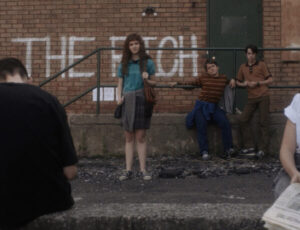The Pacific Cinematheque is one my favourite places to catch a movie and recently, this non-profit theatre screened a special series of films entitled “Paris x3”. This showcase was comprised of three movies all set in, you guessed it, Paris. On Saturday I saw one of these three when I went to the screening of the 2012 masterpiece, Holy Motors.
I made sure to stay away from reading about or watching any trailers related to the film before going. I wanted to make sure I was as surprised as possible with the story and characters and I certainly got what I wanted. My friend Richard had this to say about the film: “I don’t recall a time where I just squinted at a screen for two hours with my brain hurting from exhaustion.” Indeed, this description gives some insight into just how different Holy Motors is from other films. While the scenes changed and the complexity of the story “unraveled”; I remained in a state of confusion.
The film opens with a shot of a theatre full of sleeping audience members. Why Leos Carax–who penned and directed the feature—chose this image for his opening sequence, is a question that’s been stuck in my mind. Carax’s film is stimulating in an abnormal way and thus his shot of a sleeping audience felt like a jab at modern audiences, making fun of their devotion to stagnant film stories and formulas. A moment later, a man is shown stumbling into the sleepy auditorium, with this shot Carax represents his own re-emergence into the world of feature films. Carax, whose last feature was in 1999. He pushes the boundaries of a typical film arch and brings a variation of characters and ideas with his ambitious script and talented ensemble.
The story follows Monsieur Oscar (Denis Lavant), an actor who uses the back of a limousine as a dressing room, pushing his way through Paris from scene to scene, sporting various costumes and delving into assorted personalities. In fact, the constant shift of stories and characters means Holy Motors hinges on being a set of short films rather than a single story feature. Although this film is not a Hollywood blockbuster, it includes bits and pieces of that world we, as a present-day audience, are all too familiar with. Carax’s world integrates familiarities such as: science fiction, beautiful women, disguises, murders, musical numbers, sexuality and more.
Speaking of beautiful women, and in this case famous ones, I was interested to see cameos by Eva Mendes and Kylie Minogue. Mendes’s part, in particular, is quite memorable. Although Mendes holds little dialogue, her scenes with Lavant are as interesting as they are disturbing. Meanwhile Minogue gets to show off her vocal talent in the only musical part of the film.
By using Lavant’s ability to connect to a vast array of characters, Carax brings the actor and the craft of acting to the forefront of his film. Exploring various settings, relationships, genres and connections, Carax truly challenges the viewer into thinking about what cinema means to them. Holy Motors is a movie that must be watched with an open and well-rested mind. I found it to be refreshing, although at times disturbing, to watch. The confusion that comes with watching Holy Motors is a necessary part of its being, so I have refrained from giving away much about the characters and scenarios that appear. Overall, confusion is what drives the film as well as what makes it so memorable.








